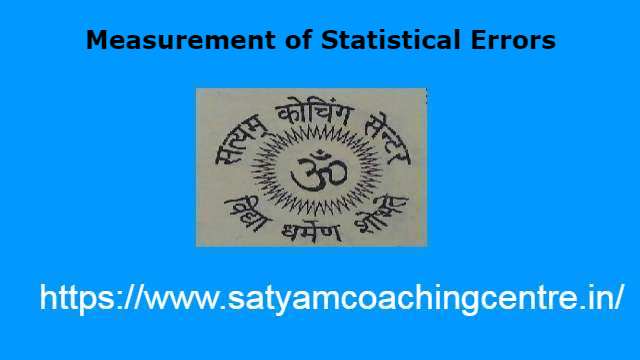Measurement of Statistical Errors
1.सांख्यिकीय विभ्रमों का माप (Measurement of Statistical Errors),सन्निकटन (Approximation):
सांख्यिकीय विभ्रमों का माप (Measurement of Statistical Errors) के इस आर्टिकल में निरपेक्ष विभ्रम,सापेक्ष विभ्रम,प्रतिशत विभ्रम तथा सन्निकटन पर आधारित सवालों को हल करके समझने का प्रयास करेंगे।
आपको यह जानकारी रोचक व ज्ञानवर्धक लगे तो अपने मित्रों के साथ इस गणित के आर्टिकल को शेयर करें।यदि आप इस वेबसाइट पर पहली बार आए हैं तो वेबसाइट को फॉलो करें और ईमेल सब्सक्रिप्शन को भी फॉलो करें।जिससे नए आर्टिकल का नोटिफिकेशन आपको मिल सके।यदि आर्टिकल पसन्द आए तो अपने मित्रों के साथ शेयर और लाईक करें जिससे वे भी लाभ उठाए।आपकी कोई समस्या हो या कोई सुझाव देना चाहते हैं तो कमेंट करके बताएं।इस आर्टिकल को पूरा पढ़ें।
Also Read This Article:- Moments in Statistics
2.सांख्यिकीय विभ्रमों का माप के साधित उदाहरण (Measurement of Statistical Errors Solved Examples):
Example:1.अभिनत विभ्रम (Biased Errors) तथा अनभिनत विभ्रम का उदाहरण दो।
Solution:वास्तविक मूल्य और अभिनत व अनभिनत अनुमान (True Values and Biased and Unbiased Estimates)
\begin{array}{|cccc|} \hline & & & \\ \text{औसत मजदूरी } & \text{वास्तविक मूल्य (रु.) } & \text{अभिनत अनुमान } & \text{अनभिनत अनुमान} \\ \hline \text { कारखाना A } & 72 & 75 & 73 \\ \text { कारखाना B } & 70 & 74 & 75 \\ \text { कारखाना C } & 78 & 81 & 76 \\ \text { कारखाना D } & 81 & 85 & 80 \\ \text { कारखाना E } & 84 & 90 & 86 \\ \hline \text { योग } & 385 & 405 & 390 \\ \hline \text { औसत } & 77 & 81 & 78 \\ \hline \text { त्रुटि } & & -4 & -1 \\ \hline \text { प्रतिशत त्रुटि } & & 4.94 \% & 1.28 \% \\ \hline \end{array}
Example:2.यदि तीन व्यक्तियों की वास्तविक आय क्रमशः Rs. 260,Rs. 510 और Rs. 1010 है तथा अनुमानित आय क्रमशः Rs.250,Rs.500 और Rs.1000 मासिक है तो तीनों स्थितियों में निरपेक्ष त्रुटि,सापेक्ष त्रुटि और प्रतिशत त्रुटि ज्ञात कीजिए।
Solution:Calculation Table of A. E., R. E. and P. E.
\begin{array}{|cccccc|} \hline & & & & &\\ & \text{वास्तविक } & \text{अनुमानित } & \text{निरपेक्ष } & \text{सापेक्ष } & \text{प्रतिशत} \\ & \text{ आय } & \text{ आय} & \text{ त्रुटि} & \text{ त्रुटि} & \text{ त्रुटि} \\ \hline I & 260 & 250 & 260-250 & \frac{10}{250} & 0.04 \times 100 \\ & & & =10 & =+0.04 & =4 \% \\ II & 510 & 500 & 510-500 & +\frac{10}{500} & 0.02 \times 100 \\ & & & =+10 & =+0.02 & =2 \% \\ III & 1010 & 1000 & 1010-1000 & +\frac{10}{1000} & 0.01 \times 100 \\ & & & =+10 & =+0.01 & =1 \% \\ \hline\end{array}
Absolute Error=Actual Value-Estimated Value
=a-e
Relative Error =\frac{\text { Absolute Error }}{ \text { Estimated value }}=\frac{A.E}{e} \\=\frac{a-e}{e}
Percentage Error=Relative Error×100
or P.E.=\frac{a-e}{e} \times 100
Example:3.एक व्यक्ति की आय Rs.400 जबकि अनुमानित आय Rs.250 है तथा दूसरे की वास्तविक आय और अनुमानित आय क्रमशः Rs.990 व Rs.1000 है।दोनों अनुमानों की त्रुटियाँ ज्ञात करो।
Solution:Calculation Table of R.E. and P.E.
\begin{array}{|l|l|l|} \hline & & \\ \text{त्रुटि (Error)} & I & II \\ \hline \text{निरपेक्ष (Absolute)} & 400-250=+150 & 990-1000=-10 \\ \text{सापेक्ष (Relative)} & + \frac{150}{250}=+0.6 & \frac{-10}{1000}=-0.01 \\ \text { प्रतिशत (Percentage) } & +0.6 \times 100=60 \% & -0.1 \times 100 =-1 \% \\ \hline \end{array}
Example:4.यदि तीन व्यक्तियों x,y और z की वास्तविक आय क्रमशः 400,730 व 1300 रु. है तो तीनों स्थितियों में निरपेक्ष विभ्रम,सापेक्ष विभ्रम तथा प्रतिशत विभ्रम की गणना कीजिए।
Solution:Calculation Table of A. E., R. E. and P. E.

Example:5.एक अनुसन्धानकर्त्ता द्वारा गेहूँ के मूल्य 125 रु. प्रति क्विंटल प्रतिवेदित किए गये जबकि वास्तविक मूल्य 150 रु. प्रति क्विंटल थे,तो निरपेक्ष और सापेक्ष विभ्रम का परिकलन कीजिए।
(An investigator reported the price of wheat to be Rs.125 per quintal,The actual price was Rs.150 per quintal.Calculate the absolute and relative error.)
Solution:Absolute Error=Actual Value-Estimated Value
=Rs.150-Rs.125=Rs.25
Relative Error =\frac{\text { Actual value- Estimated value}}{\text { Estimated value }} \\=\frac{150-125}{125} \\ =\frac{25}{125}=0.2
Example:6.दो वर्गों के सर्वेक्षण के पश्चात निम्नलिखित समंक उपलब्ध किये गये:
(After surveying the two groups,the following figure were obtained)
\begin{array}{|l|l|l|} \hline \text{वर्ग}& \text{Group X } & \text{Group Y } \\ \hline \text{वास्तविक मूल्य (Real Value)} & 204 & 1008 \\ \text{अनुमानित मूल्य (Estimated Value)} & 200 & 1000 \\ \hline \end{array}
इनमें से कौनसी स्थिति में विभ्रम अधिक है?
(In which case the error is greater?)
Solution:Calculation Table of A. E., R. E.
\begin{array}{|l|l|l|} \hline & \text{Group X } & \text{Group Y } \\ \hline \text{Absolute Error} & 204-200=4 & 1008-1000=8\\ \text{Relative Error} & \frac{(204-200)}{200}=0.02 & \frac{1008-1000}{1000}=0.008 \\ \hline \end{array}
Example:7.एक जाँचकर्त्ता द्वारा चावल के मूल्य 125 रु. प्रति 10 किग्रा प्रतिवेदित किये गये,जबकि वास्तविक मूल्य 1500 रु. प्रति क्विंटल था।निरपेक्ष व सापेक्ष विभ्रम की गणना कीजिए।
(An investigator reported the price of rice to be Rs.125 per 10kg, while the actual price was Rs.1,500 per quintal.Calculate the absolute and relative error.)
Solution:अनुमानित चावल के मूल्य =\frac{125}{10} \times 100=1250 प्रति क्विंटल
वास्तविक मूल्य=1500 रु. प्रति क्विंटल
Absolute Error=Actual Value-Estimated Value
=1500-1250=250
Relative Error =\frac{\text{ Actual value-Estimated value }}{\text { Estimated value }} \\ =\frac{1500-1250}{1250} \\ =\frac{250}{1250} \\ =0.2
Example:8.तीन व्यक्तियों A,B,C की वास्तविक तथा अनुमानित आय निम्न प्रकार है।विभ्रमों की तुलना कीजिए:
(The real and estimated incomes of three persons A,B,C are as follows.Comare the errors):
रु.
\begin{array}{|cccc|} \hline \text{व्यक्ति (person)} & A & B & C \\ \hline \text{वास्तविक आय (Real Income)} & 300 & 400 & 460 \\ \text{अनुमानित आय (Estimated Income)} & 250 & 350 & 410 \\ \hline \end{array}
Solution:Calculation Table of Absolute Error and Relative Error
\begin{array}{|ccccc|} \hline \text { Person } & \text{Real} & \text{Estimated} & \text{Absolute} & \text{Relative} \\ & \text{Income} & \text{Income} & \text{Error} & \text{Error} \\ \hline \text { A } & 300 & 250 & 300-250=50 & +\frac{50}{250}=+0.2 \\ B & 400 & 350 & 400-350=+50 & +\frac{500}{350}+0.14 \\ \text { C } & 460 & 410 & 460-410=+50 & +\frac{50}{410}=+0.12 \\ \hline \end{array}
Example:9.यदि सापेक्षिक विभ्रम 0.75 है,जबकि निरपेक्ष विभ्रम 60 है।वास्तविक मूल्य की गणना कीजिए।
(Relative error is 0.75 while absolute error is 60.Find out the Actual Value.)
Solution: Relative Error =\frac{\text { Absolute Error }}{\text { Estimated value }} \\ \Rightarrow 0.75=\frac{60}{\text { Estimated value }} \\ \Rightarrow \text { Estimated value }=\frac{60}{0.75}=80
Actual Value=Estimated Value+Absolute Error
=80+60
=140
Example:10.यदि प्रथम व्यक्ति की निरपेक्ष व सापेक्ष त्रुटियाँ क्रमशः +0.75 व +0.02 है तथा दूसरे की -9 व -0.03 है तो वास्तविक तथा अनुमानित मूल्य ज्ञात कीजिए।
Solution:प्रथम व्यक्ति के लिए
A.E.=+5,R.E.=+0.02
R.E.=\frac{A.E.}{e} \Rightarrow +0.02=\frac{+5}{e} \\ \Rightarrow e=\frac{5}{0.02} \\ \Rightarrow Estimated Value=250
Actual Value=Estimated Value+Absolute Value
=250+5
=255
दूसरे व्यक्ति के लिए
A.E.=-9,R.E.=-0.03
R.E.=\frac{A.E.}{e} \\ \Rightarrow-0.03=\frac{-9}{e} \\ \Rightarrow \text { Estimated value }(e)=\frac{-9}{-0.03} \\ =300
Actual Value=Estimated Value+Absolute Value
=300+(-9)
=291
उपर्युक्त उदाहरणों के द्वारा सांख्यिकीय विभ्रमों का माप (Measurement of Statistical Errors),सन्निकटन (Approximation) को समझ सकते हैं।
3.सन्निकटन के साधित उदाहरण (Approximation Solved Examples):
Example:11.36,78,238.69 को संख्याएँ छोड़कर सन्निकटन (approximation by discarding figures),संख्याएँ जोड़कर सन्निकटन (approximation by adding figures),निकटतम इकाई तक पूर्णांक बनाकर सन्निकटन (approximation to the nearest round figure) कीजिए।
Solution:Calculation Table of Approximation
\begin{array}{|cccc|} \hline \text{सन्निकटन अंक} & \text{By Discarding}& \text{By Adding} & \text{To Nearest} \\ & \text{Figures} & \text{Figures} & \text{Round Figures} \\ \hline \text{एक दशमलव अंक } & 36,78,238.6 & 36,78,238.7 & 36,78,238.7 \\ \text{ तक सन्निकटन } & & & \\ \text{इकाई तक सन्निकटन अंक} & 36,78,238 & 36,78,239 & 36,78,239 \\ \text{दहाई तक सन्निकटन अंक} & 36,78,230 & 36,78,240 & 36,78,240 \\ \text{सैकड़ा तक सन्निकटन अंक} & 36,78,200 & 36,78,300 & 36,78,200 \\ \text{हजार तक सन्निकटन अंक} & 36,78,000 & 36,79,000 & 36,78,000 \\ \text{दस हजार तक सन्निकटन अंक} & 36,70,000 & 36,80,000 & 36,80,000 \\ \text{लाख तक सन्निकटन अंक} & 36,00,000 & 37,00,000 & 37,00,000 \\ \hline \end{array}
तीसरी रीति सबसे अधिक वैज्ञानिक है क्योंकि इसमें कुछ अशुद्धि की मात्रा कम होती है तथा इसमें अशुद्धियाँ क्षतिपूरक (compensating) होती है।
Example:12.तीन रीतियों का तुलनात्मक उदाहरण दीजिए।
Solution:Calculation Table of Approximation
\begin{array}{|cccc|} \hline & & & \\ \text { मौलिक संख्या } & \text { अंकों को छोड़कर } & \text { अंकों को जोड़कर } & \text { निकटतम पूर्णांक } \\ \text{ (Original Figure) } & \text{सन्निकटन } & \text{सन्निकटन} & \text{तक सन्निकटन} \\ \hline 30 & 30 & 40 & 40 \\ 57 & 50 & 60 & 60 \\ 82 & 80 & 90 & 80 \\ 91 & 90 & 100 & 50 \\ 27 & 20 & 30 & 30 \\ 34 & 30 & 40 & 30 \\ \hline \text { Total } =327 & 300 & 360 & 330 \\ \hline \text { Error } & 27 & -33 & -3 \\ \hline \end{array}
उपर्युक्त उदाहरण के द्वारा सांख्यिकीय विभ्रमों का माप (Measurement of Statistical Errors),सन्निकटन (Approximation) को समझ सकते हैं।
Also Read This Article:- Seasonal Average Method
4.सांख्यिकीय विभ्रमों का माप (Frequently Asked Questions Related to Measurement of Statistical Errors),सन्निकटन (Approximation) से सम्बन्धित अक्सर पूछे जाने वाले प्रश्न:
प्रश्न:1.सन्निकटन या उपसादन किसे कहते हैं? (What is Approximation?):
उत्तर:बड़ी संख्याएँ प्रायः भ्रमात्मक और जटिल होती हैं जिन्हें समझना और स्मरण रखना अत्यधिक कठिन होता है।अतः इन्हें सरल और बोधगम्य बनाने के उद्देश्य से निकटतम पूर्णांक संख्या के रूप में व्यक्त कर दिया जाता है।इसे ही सन्निकटन कहते हैं।
प्रश्न:2.सन्निकटन के प्रकार बताइए। (State the methods of Approximation):
उत्तर:(1.)संख्याएँ छोड़कर सन्निकटन करना (approximation by discarding figures)
(2.)संख्याएँ जोड़कर सन्निकटन करना (approximation by adding figures)
(3.)निकटतम इकाई तक पूर्णांक बनाकर सन्निकटन करना (approximation to nearest round figure)
(4.)युग्मांक नियम द्वारा सन्निकटन करना (Approximation by even digits)
प्रश्न:3.सांख्यिकीय विभ्रम किसे कहते हैं? (What is Statistical Error?):
उत्तर:सांख्यिकीय विभ्रम से आशय वास्तविक मूल्य एवं अनुमानित मूल्य के अन्तर से है।
प्रश्न:4.अशुद्धि एवं सांख्यिकीय विभ्रम में प्रमुख अन्तर बताइए। (State the Main Difference Between Mistake and Statistical Error):
उत्तर:सांख्यिकी में विभ्रम से आशय त्रुटि से नहीं होता वरन एक विशेष अर्थ में होता है।किन्तु अशुद्धि से यह अभिप्राय होता है कि किसी काम को गलत ढंग से करना।अशुद्धि जानबूझकर की जा सकती है या अनजाने में हो सकती है,इसे सुधारा भी जा सकता है।अनुमान से माप करने पर शत प्रतिशत शुद्धता का आश्वासन नहीं होता है,इसी से विभ्रम उत्पन्न हो जाया करता है।
उपर्युक्त प्रश्नों के उत्तर द्वारा सांख्यिकीय विभ्रमों का माप (Measurement of Statistical Errors),सन्निकटन (Approximation) के बारे में ओर अधिक जानकारी प्राप्त कर सकते हैं।
| No. | Social Media | Url |
|---|---|---|
| 1. | click here | |
| 2. | you tube | click here |
| 3. | click here | |
| 4. | click here | |
| 5. | Facebook Page | click here |
| 6. | click here |
Measurement of Statistical Errors
सांख्यिकीय विभ्रमों का माप
(Measurement of Statistical Errors)
Measurement of Statistical Errors
सांख्यिकीय विभ्रमों का माप (Measurement of Statistical Errors) के इस आर्टिकल में
निरपेक्ष विभ्रम,सापेक्ष विभ्रम,प्रतिशत विभ्रम तथा सन्निकटन पर आधारित सवालों को हल
करके समझने का प्रयास करेंगे।
Related Posts
About Author
Satyam
About my self I am owner of Mathematics Satyam website.I am satya narain kumawat from manoharpur district-jaipur (Rajasthan) India pin code-303104.My qualification -B.SC. B.ed. I have read about m.sc. books,psychology,philosophy,spiritual, vedic,religious,yoga,health and different many knowledgeable books.I have about 15 years teaching experience upto M.sc. ,M.com.,English and science.








